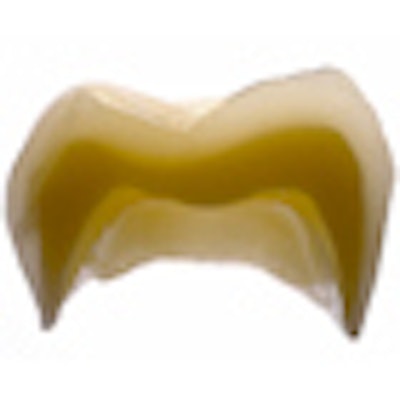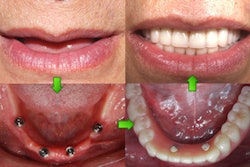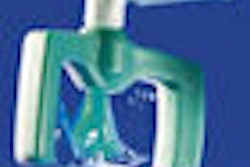
The new Lava CAD/CAM system makes crowns more quickly than Ivoclar Vivadent's IPS e.max system -- and the restorations will look better and last longer -- 3M ESPE claims.
Operators of the Lava Digital Veneering System (DVS) design both the coping and veneer by CAD/CAM before bonding the two pieces together. As a result, "we're able to get more strength and color," said Dan McMaster, marketing operations manager at 3M ESPE. "No one else is doing this."
Ivoclar Vivadent, not surprisingly, begs to differ. Asked to comment on the 3M ESPE claims, George Tysowsky, D.D.S., M.P.H., vice president of technology at Ivoclar, cited a recent study in the Journal of the American Dental Association that showed that monolithic IPS e.max restorations held up well in a two-year clinical trial (JADA, June 2010, Vol. 141: S.2, p. 10S-14S).
|
Having trouble viewing this clip? Click here to download the free Adobe Flash player. |
| The process of designing a Lava DVS crown by CAD/CAM. Video courtesy of 3M ESPE. |
PFM vs. CAD/CAM
The Lava DVS process is both faster and more reliable than the traditional porcelain-fused-to-metal (PFM) process that still accounts for 60% of the market, McMaster said.
In the PFM approach, a dentist makes a physical impression and sends that to the lab, which constructs first a stone model and then a wax pattern from which to estimate the size of the metal coping that will serve as a substructure. The technician then builds up a porcelain veneer layer by layer, firing the crown between layers. "That process is laden with potential for error," McMaster said.
CAD/CAM goes much faster and saves the patient some discomfort, he said. In this approach, the practitioner can digitally scan the patient's mouth, design the crown on a computer, then send the data to a milling machine that carves a monolithic (one-piece) crown out of a block. But what should the block be made of?
Ceramic may come closest to the natural look of a tooth, but it's not as strong as the metals typically used in a PFM.
Zirconia, with a flexural strength of 1,000 to 1,200 megapascals (MPa), is one of the hardest materials around, and it is more attractive than metal. But it still doesn't have the shades of color and translucence of a natural tooth. "It's kind of opaque," McMaster said. "You have to try to stain it to get color."
Lithium disilicate, the material for which IPS e.max is best known, is stronger than other ceramics (it has a flexural strength of 360-400 MPa, about 2.5 times stronger than any other ceramic), and it comes in four different translucencies, Ivoclar noted. This combination has made it popular. As an alternative to CAD/CAM, lithium disilicate can also be melted and poured into a mold to create a one-piece crown or a nearly complete crown to which porcelain trim is added.
Two-piece CAD/CAM
Ivoclar, like other restoratives companies, also offers zirconia products under the IPS e.max brand for circumstances in which even greater strength is desired. Because zirconia doesn't look as much like a tooth as ceramic, Ivoclar and other companies also offer an approach in which a porcelain veneer is added to a zirconia coping.
The veneer can be painted on in layers, or it can be melted and pressed onto the coping by machine.
The Lava DVS not only saves dentists from making physical impressions, McMaster said, it saves technicians from having to layer or melt porcelain onto copings. Instead, they simply fuse together two pieces -- a coping and a veneer -- both made by CAD/CAM, using 3M's Fusion Porcelain.
In a 3M survey of six labs that did 2,100 cases, the labs found this approach took 20.7 minutes per restoration, compared to 38.8 minutes for hand-layering. (The computer-aided design time was not included.)
 The series of steps in making a Lava DVS crown. Image courtesy of 3M ESPE.
The series of steps in making a Lava DVS crown. Image courtesy of 3M ESPE.
The anatomically shaped Lava DVS coping better supports the Lava DVS veneer because both are the same shape, McMaster said. "The way I look at it is like a layer of glass," he said. "If you put the glass on a carpet and stand on it, it will break. If you put it on a table and stand on it, it won't break."
Ivoclar makes its own argument for strength. "Monolithic restorations such as IPS e.max lithium disilicate have no interface between two dissimilar materials, therefore enhancing both the strength and durability of the restoration," Dr. Tysowsky wrote in an e-mail to DrBicuspid.com. And in the two-piece IPS e.max systems, the copings are anatomically designed as well, he stated.
Strength test
At the American Association for Dental Research meeting in March in Washington, DC, 3M researchers presented the results of a study in which they compared five different types of crown:
- Lava DVS zirconia copings with Lava DVS veneers
- Lava DVS zirconia copings with IPS e.max ZirPress veneers pressed on
- Nonanatomically designed zirconia Lava copings with IPS e.max ZirPress veneers pressed on
- Monolithic lithium disilicate IPS e.max CAD crowns with 1.2-mm minimum occlusion thickness
- Monolithic lithium disilicate IPS e.max CAD crowns with 1.5-mm minimum occlusion thickness
The 1.2-mm minimum occlusion thickness was used for one set of IPS e.max CAD crowns because that was the thickness in groups 1 through 3. The 1.5-mm thickness was used because that is the manufacturer's recommendation.
The researchers made 10 crowns for each group. They cemented them with 3M's Ketac Cem and loaded in a universal testing machine that gradually increased pressure on them until a decrease of force or cracking noise was noted, indicating that they had broken.
Group 1, the Lava DVS group, scored the highest fracture strength, 3715 ± 623 newtons (N), but this was not a statistically significant difference compared to group 2 (the zirconia copings with IPS e.max ZirPress porcelain veneers pressed on), which scored 3368 ± 676 N.
However, the Lava DVS group was statistically stronger than the other three groups (p < 0.05). Group 3 scored 2808 ± 680 N, group 4 scored 1373 ± 250 N, and group 5 scored 3147 ± 364 N.
So does this settle the question?
Not exactly, Dr. Tysowsky wrote. "There are many methods of testing strength of dental materials. The most important factor is the long-term clinical durability of final restorations." That's why he cited the JADA study and others -- including four years of clinical data that concluded the performance of e.max "has exceeded that of traditional PFM restorations as well as many all-ceramic restorations" (Dental Advisor, June 2010, Vol. 27:5) -- in a similar vein.
Lava won't have such data for a while, but we'll keep you posted.
Copyright © 2010 DrBicuspid.com



















